As a proud owner of a Rottweiler, I’ve come to learn so much about this amazing breed of dog. In this article, Rottweiler Overview – The Complete Pet Owners Guide, I share you with everything I’ve learned about choosing, raising, and taking great care of your Rottweiler.
We leave no stone unturned and discuss everything from setting up the home, keeping them healthy, temperament, training, and exercise needs.
We also provide lots of tips regarding their grooming and nutrition needs, along with key risks all Rottweiler owners need to be aware of. Let’s get started!
What is the breeding history of the Rottweiler?
The Rottweiler is a large, powerful breed of working dog known for its strength and loyalty. It has a rich history that dates back to the first century AD when it was used as a herding and guard dog in Germany.
Their breeding history has seen several changes over the centuries. However, one thing remains consistent: their strong temperament and ability to protect their family.
During Roman times, the ancestor of the modern-day Rottweiler was used by Roman drover dogs (cattle drivers) to herd cattle from Italy to other parts of Europe.
They were selectively bred for their intelligence, strength, perseverance, and courage. These are all qualities that still exist in today’s Rottweilers.
Rottweiler – Size and Features
The average height for an adult male Rottweiler is 24 to 27 inches, while females typically stand 22 to 25 inches tall.
“These dogs generally weigh between 80 and 135 pounds as adults, with males tending to be on the heavier end of the scale.”
In terms of appearance, Rotties have broad chests and wide heads with almond-shaped eyes that range in color from dark brown to amber.
Their coats are mostly black but may also feature tan markings above the eyes, on their cheeks, legs, and feet.
Rotties are renowned for their loyal personalities and are highly intelligent and eager to please their owners.
As devoted guard dogs, they will protect those they love without fear or hesitation.
How long does it take for a Rottweiler to be fully grown?
This breed will hit full physical maturity anywhere between two and three years old. However, their emotional growth takes longer to fully develop – usually up to five years old.
Rotties typically start growing rapidly at about six months of age. This is when they should start getting proper nutrition and exercise in order to ensure healthy growth and development.
What can affect a Rottweiler’s growth?

Rotties are a large breed and require special care to ensure healthy physical development. Knowing what can influence your pup’s growth is essential for raising a happy and healthy dog.
Diet is an important factor that affects the growth rate of any puppy, especially big dogs like Rotties. Quality food should be given at regular intervals throughout the day to provide essential nutrients for their development.
Additionally, puppies should be fed age-appropriate portions or in line with your vet’s advice. This is because overfeeding can lead to excessive weight gain and other health issues.
“The amount of exercise your pup gets also has an impact on their growth rate. A healthy weight and daily exercise are essential for keeping your Rottweiler fit and well.”
Rottweiler Essentials
Dog Bed
One of the most important items for the Rottweiler is a good quality dog bed.
When choosing the right bed for your Rottweiler, it’s important to consider their size, age, and activity level. A large breed like the Rottweiler will need something durable that can handle its weight. It also needs to offer support for its joints.
If you have an older Rottweiler who isn’t very active anymore, look for a bed with softer padding. Orthopedic foam is great for helping soothe tired joints.
On the other hand, an active puppy may benefit from an elevated bed. This will help keep them cool during warmer months.
I would suggest waiting until your puppy is past the teething and housebreaking stages before investing in a quality bed. Folded blankets are perfectly fine in the early puppy stages.
Ultimately, choosing the right bed is an important investment in your dog. I recommend a bed with a zip-off cover for easy cleaning. This is because they get dirty fairly quickly and will need regular cleaning.
I have also noticed over the years that dog beds with zipper access are typically more durable. This is largely due to the stuffing inside the bed, which is refillable if required over time.
Collar
A sturdy, reliable, and comfortable collar are key for both safety and convenience. This is especially the case when it comes to your Rottweiler’s daily walks and outings.
When selecting a collar for your Rottweiler, there are several factors to consider.
First, make sure that the fit is correct. It should be snug enough to stay put but not too tight so as to cause discomfort or irritation. A good rule of thumb is that you should be able to fit two fingers under the collar.
“Secondly, look for collars made from durable materials like leather or nylon- they will last longer and require less maintenance over time.”
Finally, choose one with features that suit your needs. Reflective details can provide added visibility during nighttime strolls, while adjustable straps can assist growing puppies or changing weather conditions.
Crate
Investing in a dog crate is a personal choice for dog owners. I also appreciate there are different views on whether they are necessary.
Largely, they are used to keep your puppy in a controlled environment when nobody is home to supervise. They are also considered a sanctuary and resting place for puppies, providing safety and a feeling of security.
They help with the prevention of undesirable behavior such as chewing and damaging house furniture. This is especially the case when puppies become bored and restless.
Crates are also a great option when housebreaking your puppy, as dogs will typically avoid soiling their own sleeping areas.
Dog crates are usually either plastic or wired versions.
The plastic crates are commonly used by airlines and offer the dog lots of privacy and a quiet area to retreat.
Wired crates are more expensive; however, this is definitely my personal preference.
They give your dog a full 360-degree view from inside their crate.
To provide an extra layer of privacy, most dog owners will also place a blanket over the crate, which helps during sleep time.
Food & Water Bowls
Choosing the right food and water bowl is so important, as some versions can pose health risks for your Rottweiler.
Plastic Bowls
While plastic bowls are very cheap. The problem is that they are easily damaged from chewing and need replacing after a short period.
The other concern with plastic bowls is that dogs can suffer from plastic dish dermatitis.
This is a problem and can cause their nose to become sore and inflamed.
Ceramic Bowls
Ceramic bowls can be easily broken or shattered if your Rottweiler gets a little rough with their bowl.
The other concern is that some ceramic dishes pose the threat of lead poisoning.
It’s therefore critical to check the dish is made from high-quality ceramic and is lead-free.
Stainless Steel Bowls
Stainless steel bowls are my recommended choice for several reasons. They are the most durable and can withstand all types of impact.
Most importantly, they don’t pose any health risks that plastic and ceramic bowls provide.
I would recommend purchasing two sets of bowls so that fresh bowls are always available for use. This provides convenience when one set is being cleaned.
Dog Gate
Dog gates are great for keeping your dog in a safe and secure environment. They are often used to keep dogs out of reach of certain household dangers.
Rottweiler owners can use them to section off parts of their home, including certain rooms that are off-limits. I’ve used these at the bottom of staircases to keep the upstairs area off-limits.
“The quality of the dog gate is important as flimsy ones will do nothing to deter an energetic Rottweiler.”
Spring-mounted models are often used as a convenient option. The ones that swing open and allow you to walk through are quite popular.
The challenge from my personal experience, is finding gates that are wide enough. I’ve often had problems finding gates that cover the distance between the wall and a doorway.
Grooming Supplies
As Rotties require a moderate level of maintenance, stocking up on the right grooming supplies is essential.
A Rottweiler’s nails need to be trimmed every couple of weeks, so a good pair of toenail clippers is essential.
To manage their thick luscious coat, a slicker brush, metal comb, and shedding blade are also necessary. These will become particularly useful during shedding times, where daily brushing will help reduce excess hair left all over the household.
Identification
The last thing any dog owner wants to hear is that their dog has gone missing and is nowhere to be found. Unfortunately, it’s not uncommon to see flyers posted on public noticeboards with photos of lost dogs.
The question often asked is whether these dogs had some sort of identification tag to identify them.
Tags
ID Tags are a great method of identifying your dog if they become lost. Tags are so useful and can easily be affixed to the collar.
It really is as simple as adding your name and contact number to the tag. This will increase your chances of your lost dog being returned.
Tattoos
In the event your pet is ever stolen, ID tags are easily disposed of. However, a tattoo is a great way to permanently identify your dog and is often located under the dog’s ear, belly area, or inner thigh.
Microchips
This is one of the best methods of permanently identifying your dog.
A microchip is a tiny device that is inserted under the Rottweiler’s skin via a very simple procedure.
The chips have radio frequency technology that can be scanned by a veterinarian to locate the dog owner’s contact information.
“While they don’t have GPS tracking, they increase the likelihood of your dog’s safe return if anybody was to find them.”
Along with being painless for the dog, microchips should be implanted after a puppy is eight weeks old. This will ensure ultimate peace of mind if they ever become lost.
In the video below, watch these 6-week-old Rottweiler puppies getting microchipped and vaccinated for the first time:
Dog Lead
A sturdy dog lead is absolutely essential, as it can literally save your dog’s life. Whenever outdoors and in an unfenced area, a Rottie should be on a lead.
Due to the strength of this breed, careful selection of an appropriate lead is required. Nylon leads are often used for puppies, however, once they get used to these a leather option is recommended.
Extendable leads are also used for convenience, as they have different lengths that can be either extended or retracted.
Dog owners could keep the lead short in crowded areas, whereas an open area like a park would suit a longer lead as they have more space to navigate.
Play Toys
As Rotties have a strong bite force of 320 pounds of bite pressure, they can penetrate and destroy most items within their sight.
While soft toys can still be provided, durability and safety should be the focus when buying these items. Hard rubber toys or squeaky balls are always a hit in my experience.
As Rotties are an intelligent breed, providing them with toys stuffed with edible treats can be highly stimulating for them. It’s a great way to keep their brains active through problem-solving, along with being rewarded for their efforts!
Rottweiler – Health Problems

While Rottweilers can suffer from a variety of health problems, many of these are avoidable. The following is a list of the more common health issues this breed may encounter:
Hip Dysplasia
Due to their large muscular build, some Rottweilers can suffer from hip dysplasia.
“This is when the hip joint does not fit snugly into its socket, leading to pain and stiffness in the hips”.
It can happen to any breed of dog, but it is more common in large breeds like the Rottweiler. The best way to make sure your Rottie stays healthy is through regular check-ups with your vet.
The vet will examine your pup’s hips for signs of dysplasia and may take x-rays if necessary. If your pup does have hip dysplasia, there are treatments available that can help them feel better and stay mobile.
Exercise and weight management are also essential for keeping joints healthy over time!
Gastric Dilatation (Bloat)
Bloat is a serious medical condition that can affect all kinds of dogs, including Rottweilers.
It’s important for people who own a Rottie to be aware of the signs and symptoms associated with bloat. Bloat happens when the stomach fills with gas or fluid, causing it to distend or swell up. This can cause pain in the abdomen and difficulty breathing.
In some cases, it can even lead to death if not treated immediately by a veterinarian. If you think your Rottie may be suffering from bloat, take them to the vet right away!
It’s also important to recognize potential risk factors for bloat such as overeating or eating too quickly.
Von Willebrand’s Disease
Von Willebrand’s Disease is a health problem where the dog’s body can’t make enough of something in its blood called “clotting factors.”
Clotting factors help stop bleeding when a dog gets hurt or cuts itself.
“This is a terrible disease that can affect some Rotties over their lifetime, causing them to bleed too much.”
Dogs with Von Willebrand’s Disease don’t have enough clotting factors, so they tend to bleed more than normal when they get hurt. While there is no cure for this condition, Rotties can be treated with blood transfusions if the condition becomes serious.
Hypothyroidism
Hypothyroidism is a condition that affects the thyroid gland in dogs. Rottweilers, like many other breeds of dogs, can suffer from this disorder.
The thyroid is an important part of the body because it sends hormones to other parts of the body that help important functions run smoothly.
When a dog has hypothyroidism, their thyroid doesn’t work correctly. This means it can’t make enough hormones to keep its body running properly.
This can cause a lot of different symptoms such as weight gain, hair loss, and lethargy.
It’s important for Rottweilers suffering from hypothyroidism to get regular check-ups with the vet. They should take medicine when prescribed to treat the problem.
Heart Disease
Rottweilers are prone to developing certain types of heart diseases, including dilated cardiomyopathy (DCM).
This is an enlargement of the heart muscle, and is quite dangerous.
The other condition is atrial septal defects (ASD), which is an abnormal opening between two chambers of the heart.
These conditions can cause symptoms such as difficulty breathing, coughing, weakness, fainting spells and even sudden death in extreme cases.
Fortunately, there are treatments available for both conditions.
Rottweiler – Temperament
Does the Rottweiler have Sensitive Feelings?
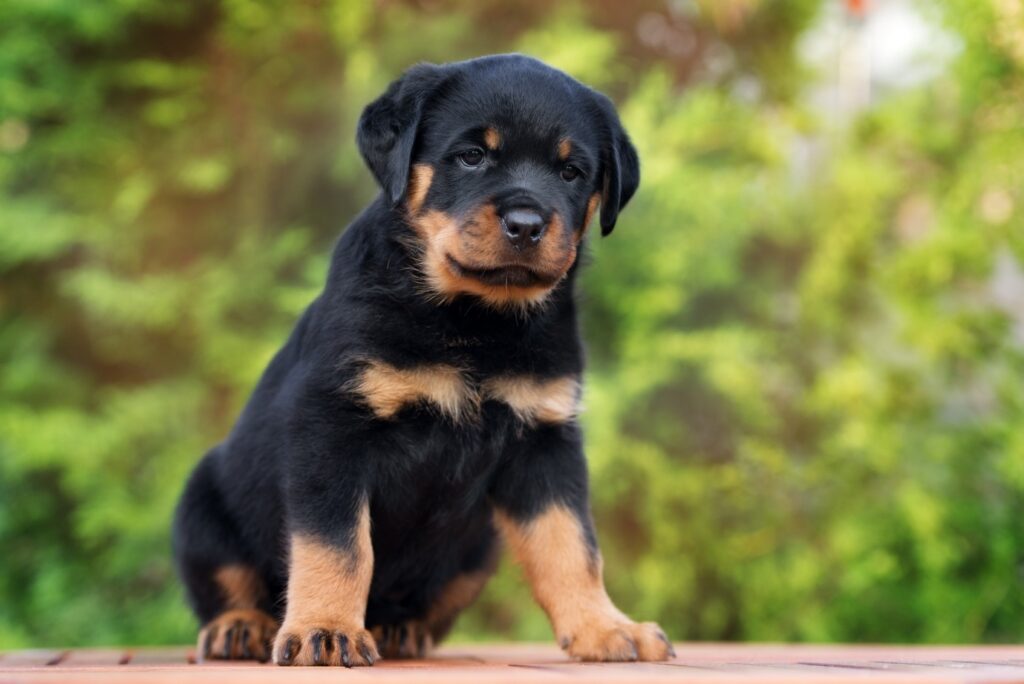
When it comes to the Rottweiler, many people have misconceptions about their temperament. Though they may be seen as intimidating or aggressive, the truth is that most Rotties are very loyal and loving dogs.
Contrary to popular belief, these canines do indeed possess sensitive emotions and feelings.
This breed has a strong bond with its owners and is known for showing strong signs of devotion towards them. They crave love and attention and will often follow their owners around, seeking interaction or praise.
Additionally, they take on an active role in protecting their family against any potential threats. This is their way of showing just how much they care for their beloved humans!
“The emotional capacity of Rotties should not be underestimated; these canines are intelligent animals with deep-seated loyalty and natural sensitivity.”
Does the Rottweiler Get Separation Anxiety?
Rotties can be prone to separation anxiety at times, depending on how the dog has been raised and looked after.
Separation anxiety in dogs is caused by an emotional attachment to their owners. This can be a problem that leads to distress when they are away from them.
Symptoms can include whining and barking when left alone, along with destructive behavior.
I’ve personally experienced our Rottie chewing or digging on furniture. We’ve even had elimination issues where they have urinated in the house!
These behaviors can range from mild to severe depending on the individual dog’s personality.
Dogs that are left alone for long periods of time while the owners are away may be more prone to the disorder. The dog can become so distressed that it will not eat or drink while they wait for its owner’s return.
Fortunately, there are ways for pet owners to help reduce their pet’s separation anxiety.
Separation anxiety is not a disorder that will go away on its own. But the good news is that it can improve if you decide to take action to address it.
In order to help your pet, you will need to make some changes in their daily routine.
Step 1
Determine if your dog has separation anxiety. There are some tell-tale signs that may indicate your dog is suffering from the disorder.
Separation anxiety can include any of the following symptoms:
- Acting depressed, lethargic, and withdrawn.
- Shake or shiver excessively.
- Destroy furniture, carpets, or other objects while you’re gone.
- Urinate or defecate inside when left alone.
- Escape from the yard or run away.
Step 2
Examine your schedule and routines to determine if they are causing the problem. You may be indirectly encouraging your dog’s separation anxiety.
For example, if you allow your pet to sleep in your bed and then leave for work in the morning, he or she may become anxious when left alone.
Step 3
Keep a record of everything that happens while you are gone. Note the time you leave, return, and anything unusual that occurred.
Then look for patterns in your pet’s behavior.
Step 4
Provide a safe place for your dog to be while you are gone. This could be a crate, pen or room where the animal cannot escape or destroy furniture.
The place should be comfortable and well-ventilated.
Step 5
Take your dog out for a long, brisk walk before you leave. Exercising will help tire him out so that he is less likely to bark or whine from boredom or discomfort.
Step 6
Give your dog something to do. Dogs need a job, such as learning tricks or playing with toys. This will help make the time pass more pleasantly for them.
Step 7
Consider setting a timer to go off every 30 minutes. This will give your dog the idea that you are coming back shortly.
Step 8
Leave on radio or television noise, such as music or talk radio, for your dog’s entertainment.
Step 9
Make arrangements with a friend or neighbor to check in on your dog. You can also organize a pet sitter to stop by to feed, walk and play with your dog.
By following each of the above steps and suggestions, you should notice a significant difference in the anxiety levels of your Rottie over time!
Does the Rottweiler need a companion?

When it comes to considering whether or not a Rottweiler needs a companion, there are plenty of factors to consider. For starters, the breed is known for being loyal and devoted to its family.
However, depending on their age and personality, some Rotties may benefit from having another pup in the family.
A puppy will often bond closely with one person in particular. However, if there is another dog in the house they’re less likely to become over-dependent on that one person.
A second pup can also provide companionship when you’re away at work or running errands.
If your Rottweiler is used to spending long periods alone each day then adding an additional canine friend could be an ideal solution.
Another point to consider is that two dogs playing together can burn off excess energy more quickly than when exercising alone.
At What age should a Rottweiler Calm down?
This breed should start to show signs of calming down by the age of two. They typically reach their full maturity by three years old.
“At two years old, you will probably notice your Rottweiler slowing down some but still has a lot of energy.”
This is normal behavior for dogs in this breed as they continue to test their boundaries and explore new places and things.
As they enter adulthood at three years old, they should start to see even more changes in temperament.
How to Calm a Rottweiler?
The first step in calming a Rottweiler is to create an environment that encourages relaxation.
Make sure the dog’s space has no distractions such as toys or loud music that could cause him or her to become overstimulated.
“Establishing a regular routine with plenty of walks and playtime helps ensure the dog feels secure and less likely to become aggressive.”
The next step is to establish yourself as the alpha dog in your household. If you have other pets, make sure they accept you as their leader before bringing a Rottweiler into the house.
The dog should be seen as a part of the family and not just as another pet.
Finally, make sure your pup gets enough exercise so that he can burn off some of his excess energy.
Additionally, playing fetch or tug-of-war games with your pet will help engage his mind while providing him with physical activity.
Are Rottweilers good emotional support dogs?
Rotties are often known for their intimidating strength and size. But did you know that they can also make excellent emotional support dogs?
These loyal companions have been gaining popularity as a breed of choice for emotional support animals (ESAs) in recent years.
This can be great for those that suffer from anxiety, depression, or other mental health issues.
An emotional support dog can provide much-needed comfort and peace of mind.
Rotties are an ideal choice because they are smart, affectionate, and incredibly devoted to their owners.
With the right training, they can be patient and gentle enough to serve as effective companion animals.
Not only do these dogs make great ESA’s — they’re also highly intelligent, which makes them great service dogs too. Coupled with a natural protective instinct, they also make great guardians!
Is a male or female Rottweiler better?
It’s important to look at all aspects of a dog’s genetics and behavior before choosing.
The Rottweiler has been prized as a loyal and protective breed, but is there any difference between male and female Rottweilers?
Many people believe that male Rotties are better guard dogs. But when considering which gender may be best for you, it really depends on what kind of lifestyle you lead.
The size of the male makes them an ideal choice for larger households or those with more active lifestyles.
They are usually stronger than females and can provide added protection against intruders or other animals.
“On the other hand, females tend to be smaller in stature and generally easier to handle when out for walks or training sessions.”
Females can also potentially display fewer dominance-related behaviors than males due to their lower testosterone levels.
Living with a dog is a big responsibility, and you should think carefully about which gender will be right for you. Both males and females can make wonderful pets but are more suited to certain people than others.
Are Rottweilers only suitable for experienced dog owners?
When it comes to choosing a dog, many first-time dog owners may shy away from the Rottweiler breed.
This is due to their reputation as an aggressive and dangerous breed. But are they really only suitable for experienced dog owners?
In truth, Rotties can make great pets—but they do require an experienced hand at the helm.
“Like any other breed, Rotties must be trained and socialized from puppyhood in order to become well-mannered adults.”
Without this training, they can become challenging to handle as adults. They also need lots of exercise and mental stimulation throughout their lifetime.
It’s important that any owner understands these needs before committing to the breed.
For those with experience handling large dogs or a strong commitment to proper training and care, a Rottweiler can make a great companion animal.
Are female or male Rottweilers more protective?
Rotties have been bred to be loyal watchdogs and are known for their courage and protectiveness. So which gender makes a better guard dog?
Experts agree that it is not the gender of the Rottie that determines its protective nature. It’s based on how it is raised and trained.
A well-socialized pup with basic obedience training will likely form strong bonds with its family and feel responsible for keeping them safe.
Female Rotties may be slightly more alert than males due to their natural mothering instinct.
However, both genders can make excellent guard dogs if they receive proper care.
Do Rottweilers love all family members equally?
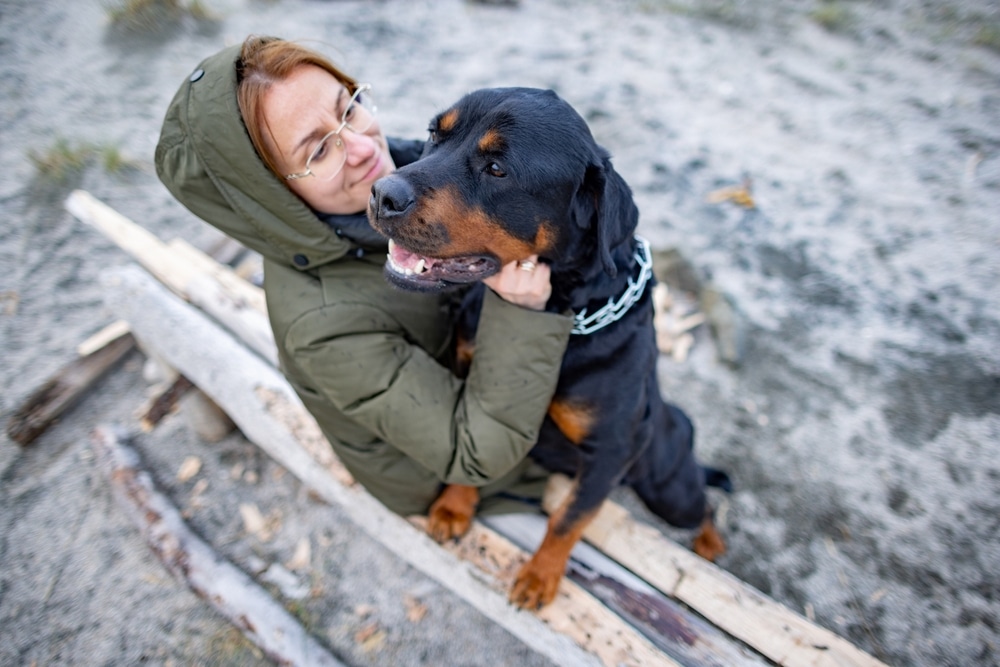
From experience, Rotties definitely form strong bonds with certain people in the house. This bond may be stronger because of the amount of time spent together or due to particular activities they engage in as a duo.
This could be a regular exercise partner they gravitate to or the main person in the household that feeds them.
However, this doesn’t necessarily mean that other family members won’t receive just as much love from the pup.
With proper socialization, your Rottweiler will learn to accept everyone in your home. They are likely to show signs of affection towards all family members.
Does a Rottweiler trust easily?
Rotties can be quite wary of people outside of their immediate family or circle of friends.
In order for them to fully trust someone new in their life, a process of socialization and positive reinforcement should take place over time.
This starts with small interactions such as allowing your Rottie to sniff out the person’s scent while providing treats as a reward.
“Gradually increasing the duration of interaction will help build up a strong bond between the Rottweiler and its new companion.”
Rottweiler – Training Needs

Is a Rottweiler Easy to Train?

The good news is that Rotties are highly obedient and loyal due to their natural guarding instincts. They will naturally want to please their owners.
They also respond well to positive reinforcement techniques such as treats and verbal praise. So providing lots of this during training sessions will encourage them to learn quickly.
So, as long as the above is applied then you shouldn’t have too many difficulties in training your Rottweiler.
Why is the Rottweiler so Stubborn?
Rotties are known for their strong will and stubborn nature. The breed is a loyal companion but can be difficult to train at times, due to their independent spirit.
Understanding why Rotties are so stubborn can help owners develop a successful training plan for their pup.
The first reason Rotties may be stubborn is because of their intelligence. This breed has been bred for countless generations to have exceptional problem-solving skills and independence.
“They are able to think for themselves which can make them resistant to commands that they don’t understand or agree with.”
Rotties also respond better to consistent and calm leadership from their owners.
If an owner becomes too emotional or aggressive during training, it could cause the dog’s natural instinct for dominance to kick in.
This may result in them refusing any commands given by the owner.
SIMPLE RULES FOR TRAINERS
Giving Commands
· Focus on tone of voice
· Keeping it simple
· Use the same commands each time
· Using the word ‘No”
· Keep talking to a minimum
Potty Training
Is it Hard to Potty Train a Rottweiler?
Potty training a Rottweiler can be a challenging and time-consuming task.
This is especially true if an owner has never potty trained a dog before and may not have the necessary experience or knowledge to do so effectively.
“Many people believe that due to their large size, intelligence, and stubbornness, Rotties are difficult dogs to potty train.”
However, this is simply not true – with the right approach and patience, it is possible to successfully potty train a Rottweiler in just a few weeks.
It is important for owners of Rotties to understand that every dog learns differently.
Some respond well to positive reinforcement, while others may require more intensive methods such as crate training or clicker training.
How Long Can a Rottweiler Hold their Bladder?
Adult Rotties typically have the ability to hold their bladders for up to 8 hours. This will depend on age, health, size, and activity level.
Puppies should be taken outside more frequently—every two hours or so—as their bladders are still developing.
Additionally, it’s important to note that holding it too long may cause a Rottweiler discomfort or even damage the bladder if left untreated.
To avoid accidents indoors, establish a potty routine and stick with it as much as possible!
How to Stop my Rottweiler from Peeing in the House?
The key to preventing your Rottweiler from peeing inside your home is consistency with training, patience, and understanding.
Start by ensuring that your pup has frequent trips outdoors so they can relieve themselves in an appropriate area.
“Reward them with treats when they do this correctly to reinforce positive behavior.”
If you catch them in the act of peeing indoors, immediately take them outside and make sure they finish there. Keep in mind that frequent and uncontrollable urinating may be a result of urinary health problems, which should be investigated further by your vet.
Never scold your dog for accidents because it will only confuse or scare him.
Obedience Training
Training a Rottweiler to walk beside you
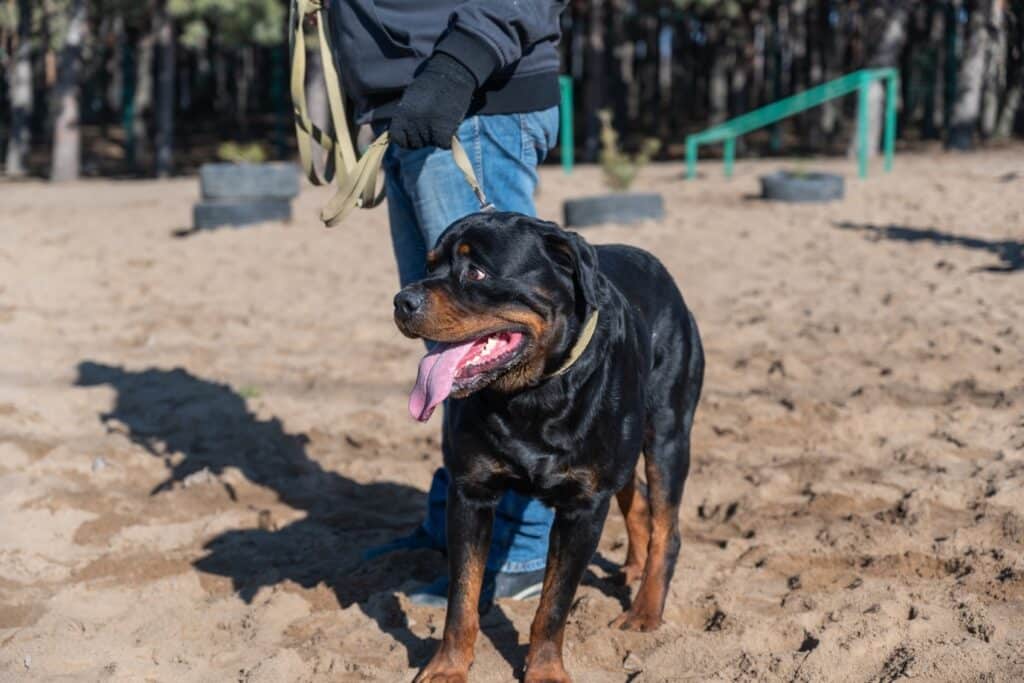
Training a Rottweiler to walk beside you is not an easy task but with dedication and patience, it can be done.
Rotties are known for their strength and intelligence which makes them one of the top guard dog breeds.
With that in mind, teaching your Rottweiler how to properly walk beside you while on a leash is essential both for safety and control reasons.
It may take some persistent work on your part, but following certain steps will help you achieve success when training your beloved pup.
Start by establishing yourself as the leader of the pack right away; this will create a foundation of trust between you two and make it easier for them to understand what is expected from them during training sessions.
Take your pup outside on regular walks, twice a day if possible; always keep their leash short enough so that they stay close to your side at all times.
Reward them with a treat or toy every time they stay by your side; dogs are very quick to pick up on positive reinforcement.
If you don’t correct them when they disobey you, it will be difficult to make them realize that there is a difference between the two actions.
Teaching a Rottweiler to Heal
Teaching a Rottweiler to heal is an important skill for any pet owner.
Not only does it help keep the dog safe and in control, but it also encourages a sense of trust between the owner and their canine companion.
To train a Rottweiler to heal, there are several steps that must be followed.
The first step is to introduce the command “heel” to your pet by getting them to sit next to you with their hindquarters slightly behind you.
Once this has been achieved, it’s time for some positive reinforcement; reward your pup with treats or praise when they stay near your side as you move around.
At this stage, progress should be made slowly so that your Rottweiler can get used to walking at heel before moving onto more advanced commands such as changing direction or stopping on command.
After your Rottweiler has got to grips with changing direction and stopping, you can start teaching them to heal in a variety of situations.
When it comes to healing, practice makes perfect!
How to Train Your Rottweiler that Keeps Biting?
If your Rottweiler has become increasingly aggressive and is exhibiting excessive biting, it’s time to take action in order to keep both you and your pet safe. This is especially the case if you have children in the family home.
The first step in addressing this issue is to identify the source of the problem.
Is your Rottweiler fearful or simply too playful? Understanding his motivation will help you determine how best to approach training him so he stops biting.
“Once you’ve identified the problem, it’s important to provide consistent discipline every time your pup exhibits this kind of behavior.”
Give clear verbal cues such as “no” when he bites and immediately move away from him if necessary.
When Should You Start Training a Rottweiler?
When it comes to training a Rottweiler, the earlier the better. Starting your pup’s training while they are young is essential to ensure they grow up as well-behaved dogs; however, when is the ideal age to start?
“The consensus is that you should begin training a Rottweiler as soon as possible. This means at around 8 weeks old!”
During this time, puppies are at their most impressionable and eager to learn, so it is important to capitalize on this period of time by teaching them commands and good behavior.
Starting a pup’s training early on will encourage positive behaviors in adulthood.
Teach your puppy basic commands such as sit, stay and come using treats and verbal rewards for the successful completion of tasks.
Rottweilers Need Discipline
It’s important to remember that all dogs need some level of discipline, including Rotties. With the right training and guidance, these powerful dogs can become loyal companions who enjoy spending time with their owners.
On top of providing them with basic obedience training, it’s also important to provide consistent guidance when it comes to setting boundaries for your Rottie.
“Setting up rules for behavior will help your pup learn what is acceptable in the house and what isn’t.”
Consistently praising good behavior and discouraging bad behavior (such as jealousy or being overly territorial) can go a long way toward helping your pup understand what you expect from them.
Rottweiler – Socialization
Why Socialization is Crucial
Socialization is key for any pet, but it’s especially important for Rotties. This breed of dog is known to be incredibly loyal and protective, so proper socialization can help ensure they are happy and well-behaved.
Socializing a Rottweiler correctly can also provide them with valuable skills such as how to interact with strangers and other animals, which can result in fewer behavioral issues in the long run.
For young puppies, socialization should begin as soon as they’re old enough to safely interact with other people and animals.
Owners should introduce their pups to different environments while they’re still young, allowing them to meet new people regularly and explore their surroundings without fear or aggression.
It’s important that these experiences are positive so that Rotties learn to trust their owners and those around them.
Rottweiler – Exercise Needs


Are Rottweilers high-energy dogs?
Rotties are high-energy dogs that were bred to drive cattle from one place to another.
As such, they have an impressive work ethic and require physical activity for mental stimulation and satisfaction.
“A walk around the block or playing a game of fetch won’t be enough for these strong, independent working dogs.”
They need more vigorous activities such as running or agility courses.
While some breeds are known for being couch potatoes, that isn’t true of Rotties.
These energetic pups need plenty of exercise and mental enrichment daily in order to stay physically fit and emotionally balanced.
Keep in mind that Rotties are prone to hip dysplasia in their latter years, so exercise for senior Rottweilers should be modified.
Are Rottweilers Fast Runners?
Rotties are not the fastest breed of dog out there. On average, they reach speeds of up to 25 mph when running full speed.
This is impressive for sure, but it falls quite short compared to some other breeds like Greyhounds or Salukis who can reach speeds of up to 45 mph!
However, the strength and agility that come with the breed more than make up for their lack of speed.
Can a Rottweiler be Off Leash?
There are several factors to consider before allowing a Rottweiler to roam freely.
First and foremost, owners should make sure that their pup has had adequate training and socialization.
A well-behaved Rottweiler will have better control over its impulses and won’t be as likely to wander away or create problems with other animals or people in the area.
Additionally, having a secure understanding of commands such as come and stay will help keep your pup safe while off-leash.
In addition to proper training, owners should always assess the environment before letting their dogs off the lead.
Agility and Rottweilers

Rotties are a reasonably agile breed of working dog that possess a combination of strength, speed, and athleticism.
They have the ability to quickly change direction and jump over obstacles with ease.
Being an active breed, this makes them well-suited for activities such as agility training or flyball competitions.
“However, due to their muscular build, they’re not as agile as certain breeds such as border collies and greyhounds.”
They are also prone to hip problems later in life, which can affect their level of agility.
Are Rottweilers Good at Hiking?
While not all Rotties are suited to a hike outdoors, many can handle longer distances with plenty of energy and enthusiasm.
They have an innate ability to track scents, which makes them an ideal hiking companion.
Additionally, they’re loyal and protective of their owners, so they’ll make sure you stay safe on your excursions.
However, it’s important to note that Rotties require proper training when it comes to being outside – otherwise they could become overwhelmed or stressed due to unfamiliar sights and smells.
Can Rottweilers Swim?
First off, Rotties tend to be heavy dogs. This means that they may not be able to stay afloat as easily as other breeds.
Additionally, because of their large size and muscular build, they have more difficulty with the coordination required to swim.
And yet, despite these challenges, many Rotties still find ways to enjoy time in the water.
Rottweiler – Mental Stimulation
Rotties are intelligent, loyal, and brave dogs that need more than just physical exercise. Just like humans, mental stimulation is needed to keep these dogs stimulated and happy.
Mental stimulation for Rotties can take many forms such as puzzle toys, training classes, or even simple commands.
Puzzle toys are a great way to provide mental enrichment for your pup by challenging them to work out how to get the treat from inside the toy.
Training classes not only help with obedience but also help stimulate their minds as they learn new tasks and tricks.
Experimenting with different commands will also help keep their brains active.
Does a Rottweiler Need Much Space?
While they’re not an overly large breed, Rotties do require some room to roam around and exercise.
They should be provided with enough space so that they can move freely inside the house or outside in the garden. Howver, it’s not necessary to have acres of land for them to roam around.
Regular walks are essential for this active breed, as well as playtime in the garden if you’re lucky enough to own one.
A large yard or open field is ideal for playing fetch or letting off steam when needed.
Do Rottweilers like toys?

Whether you’re a first-time Rottweiler owner or have been living with this loyal and affectionate breed for years, there are some fun and exciting toys that will keep your pup entertained.
One of the best types of toys for a Rottweiler is a chew toy. Chew toys can help keep their teeth clean by removing tartar and plaque from their teeth while providing hours of playtime fun and brain exercise.
“For more active dogs, interactive dog puzzles are great options as they provide mental stimulation as well as physical exercise.”
Puzzle games also challenge them to think so they won’t get bored easily.
Rottweiler – Special Skills
Rottweilers and their Sense of Smell
These intelligent dogs have a keen olfactory ability that surpasses most breeds, making them great guard dogs and scent-detection workers.
“Rotties possess up to 300 million olfactory receptors in their noses.”
This makes them incredibly skilled at sniffing out danger or any type of scent-related clues.
They can even detect the presence of other animals from far away due to their heightened sense of smell.
Additionally, Rotties are used by law enforcement agencies as drug and explosives detectors because of their sharp noses.
Like all canine breeds, Rotties rely heavily on their sense of smell for survival and communication.
In the video below, watch these Rottweilers put to the test to see how good their sense of smell really is!
Are Rottweilers good search and rescue dogs?
This large and powerful breed boasts a long history of loyalty and courage, making them ideal for various roles as search and rescue dogs.
The combination of strength, intelligence, endurance, and protective instincts make Rotties especially suited for working in demanding search and rescue environments.
They are able to cover vast amounts of ground quickly with their natural agility. This enables them to locate missing persons more efficiently than human searchers alone.
Rottweiler – Grooming Requirements

How often should a Rottweiler be Bathed?
Generally speaking, for most Rottweilers, it is recommended to bathe them every two to three months.
This allows time for the natural oils in their fur to build up, which helps maintain their skin health and coat shine.
Longer hair breeds may need more frequent baths in order to keep dirt from getting matted in the fur.
Additionally, if your pup spends plenty of time outdoors playing or gets into scraps with other animals, then you’ll want to give them a bath more often than usual.
How to Groom a Rottweiler for Summer?
A regular brushing routine should be established during the summer months due to the constant shedding of hair that occurs when temperatures increase.
This will help reduce excess fur around the home and keep your pup looking neat and tidy throughout the season.
Also, trimming nails every few weeks will help prevent discomfort caused by long nails digging into the skin while running or playing outdoors.
Do Rottweilers shed?

Overall, Rotties are considered moderate shedders compared to other breeds like German Shepherds and Golden Retrievers, who are heavier shedders.
Owners should expect regular maintenance brushing at least twice weekly in order to minimize loose hairs on furniture and clothing items throughout their homes.
As with all dogs, proper nutrition can help keep shedding in check as much as possible.
What kind of brush should be used for a Rottweiler?
The best brush for a Rottweiler should be made of soft yet sturdy bristles that will help to remove any dirt or debris from their coat without damaging it in any way.
It should also have a comfortable handle that will make the brushing process easier and provide you with better control over the strokes.
“For longer-haired breeds, look for brushes with long pins for removing tangles.”
Short-haired breeds may need something with shorter pins or even just a slicker brush instead.
How can I make my Rottweiler smell better?
First and foremost, good hygiene is essential when it comes to making sure your Rottie smells nice.
Regular baths with a canine-specific shampoo are important for keeping your dog clean and smelling good.
Make sure to thoroughly rinse off the shampoo after washing, as any residual soap will leave an unpleasant odor on your pup’s coat.
You should also consider investing in some quality pet grooming supplies such as brushes and combs. These will help keep your dog’s fur free of dirt and debris, which can cause bad odors.
In addition to regular baths, diet is also important when it comes to keeping your Rottweiler smelling fresh.
Nail Care
Nail trimming is important as long nails on a Rottie can cause discomfort and difficulty walking or running over hard surfaces.
“It’s best to start clipping your Rottweiler’s nails from when they are puppies so they get used to the process early on.”
Many pet stores offer affordable grooming tools specifically designed for dog nail grooming; which are often easier and safer than traditional clippers.
Ear Care
A Rottweiler’s ears require special attention and care to keep them healthy.
Just like humans, Rotties are prone to ear infections and other ear problems if their ears are not properly cared for.
Taking the time to clean and inspect your pup’s ears regularly will ensure that they stay happy and healthy.
Rotties have floppy ears which provide an ideal environment for yeast, bacteria, dirt, parasites, and moisture buildup.
This is why it is important to check your dog’s ears frequently for any signs of infection, such as redness, tenderness, or a bad smell coming from the ear canal.
If you notice any of these symptoms, you should take your pup to a vet as soon as possible.
Eye Care
As with all dogs, the eyes of your Rottweiler should be checked regularly to ensure they are healthy and functioning properly.
“Proper eye care can help prevent infections, corneal ulcers, glaucoma and other vision issues that can occur in this breed.”
It is essential to inspect your Rottweiler’s eyes daily for any signs of discharge or redness.
If you notice anything unusual, it is best to take them to the vet right away so that they can examine the eye further and provide appropriate treatment if necessary.
Regular check-ups with your vet will also help catch potential eye issues early on before they become more serious problems.
Dental Care
Good dental care is essential for Rotties, as it is for all dogs.
Not only does proper dental hygiene prevent bad breath and tooth decay, it can also help ward off more serious diseases such as periodontal disease and gingivitis.
Without proper care, these illnesses can take a toll on the health of your four-legged friend.
Rotties are prone to certain oral health problems, including tartar buildup and gum disease due to their lower jaw shape.
Therefore, owners should pay special attention to their pet’s oral hygiene routine by brushing at least twice a week with toothpaste specially formulated for dogs.
Additionally, annual visits to the vet are necessary in order to detect any signs of dental disease or infection early on and begin treatment if necessary.
Rottweiler – Nutrition

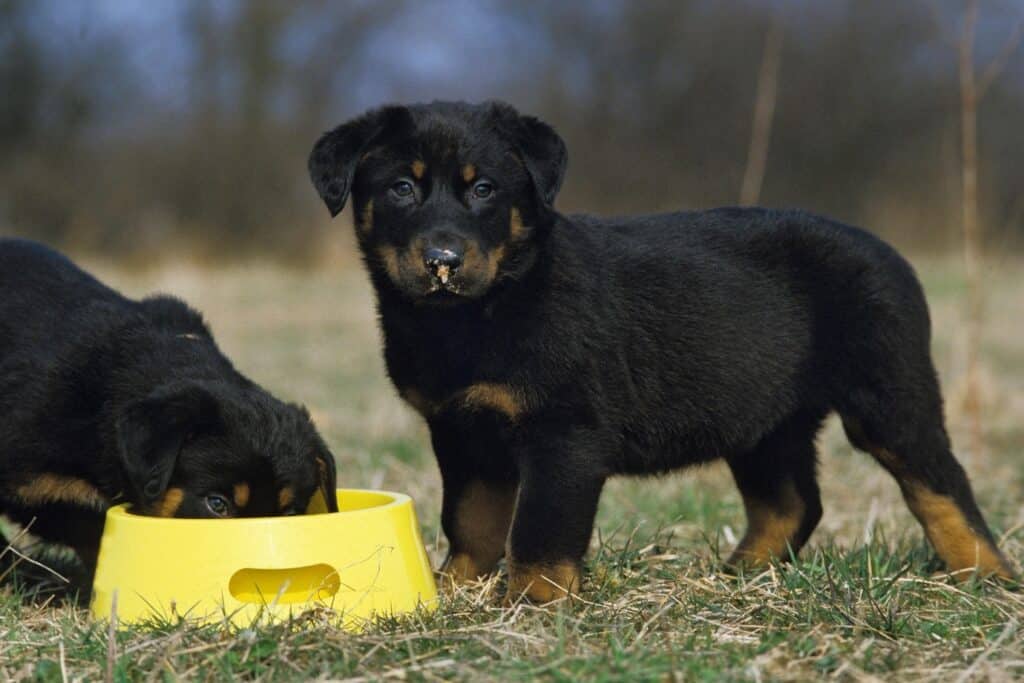
What Can a Rottweiler Eat?
A Rottweiler is a large, powerful breed of dog, and as such, it’s important to ensure that they get the right nutrients from their diet.
There are plenty of options for both wet and dry food that can provide your Rottie with the balanced nutrition they need.
We explore these below:
Nutrients
A Rottweiler’s diet should include proteins, carbohydrates, fats, vitamins, minerals, and fiber.
Protein is an important source of energy for Rotties. Sources of protein such as lean meats like chicken or fish provide essential amino acids that are necessary for proper growth and development in Rotties.
Carbohydrates are also important for providing energy to their muscles during exercise. Whole grain cereals or vegetables like potatoes can be used as sources of carbohydrates in a Rottie’s diet.
“A good ratio for a Rottweiler’s diet is 10-15% protein, 55-60% carbohydrates, and 20-25% fats. Fats are essential for growth as well as to produce energy.”
Saturated fats should be kept to a minimum as they have been linked to various health problems, including heart disease.
Raw Diet
Raw diets for dogs have become increasingly popular in recent years.
Many pet owners are choosing to feed their canine companions a raw diet instead of the traditional dry kibble or canned wet food. This comes down to personal preference, and there will always be different views on this subject.
Having said that, there are some things to consider before switching your pup to an all-raw regimen.
Firstly, it’s important to make sure you’re providing your Rottie with enough nutrients and vitamins through the diet by consulting with a veterinarian or animal nutritionist who specializes in raw feeding.
Additionally, there may be risks associated with bacteria contamination due to handling and storing uncooked food items.
Proper sanitation should therefore be practiced when handling any type of animal protein intended for human consumption, as well as for your pet.
Can a Rottweiler Eat Table Scraps?
When it comes to feeding a Rottweiler scraps from the table, moderation is key.
While some table foods are safe and nutritious for them to eat in small quantities, others can cause serious health problems if consumed in large amounts.
For example, onions and garlic can be toxic to Rotties and should be avoided altogether.
Additionally, high-fat foods like bacon can cause weight gain and lead to other related medical issues like pancreatitis.
Can Rottweilers chew on bones?
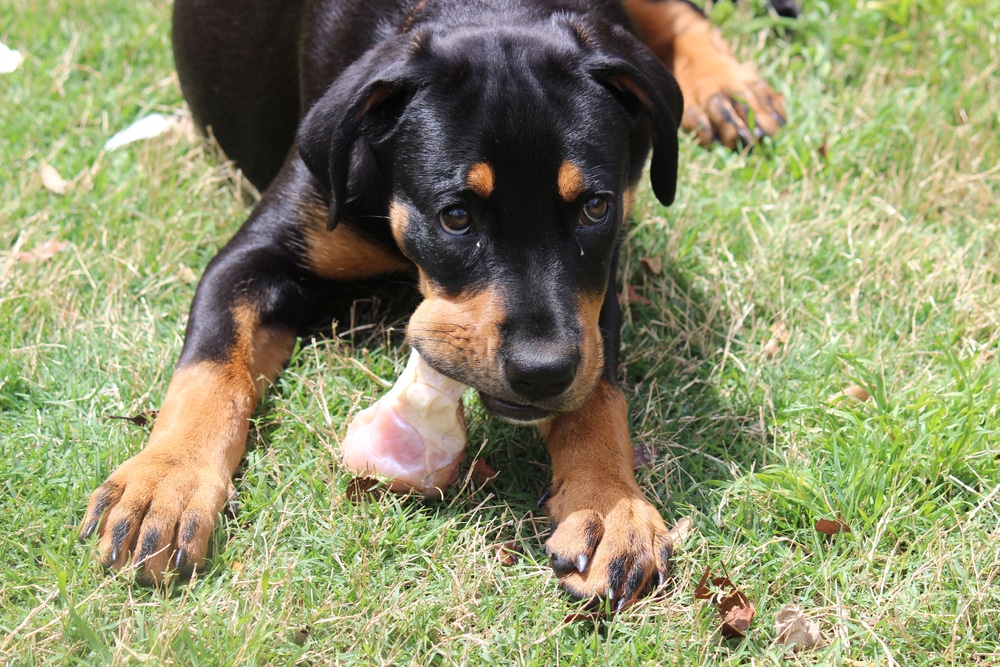
The type of bone that a Rottweiler chews on is important when considering its safety level.
Small bones that can be easily swallowed by your dog pose a huge risk to their health. Likewise, any bones that have been cooked or cut also pose a risk, as they can easily splinter.
“Bones that splinter increase the risk of your dog choking and damaging their mouth, throat, and even their intestines.”
On the other hand, knuckle or femur bones are large enough for your Rottie to safely chew on. Raw beef bones are a great option, along with bison knuckle bones.
What Supplements are Good for Rottweilers?
While supplements are not always needed by Rotties, they do help provide essential vitamins and minerals that may not be found in regular dog food.
High-quality supplements are also beneficial for older Rottweilers who may require additional nutrients for joint health or digestive issues.
Additionally, if your pet is very active or involved in an intense exercise program, it may benefit from additional protein and other nutrients to support muscle growth and energy levels.
Essential fatty acids, such as omega-3 and omega-6, are important for any dog’s diet.
Omega-3 in particular, helps support eye health, joint health, and skin integrity. Vitamin E is another critical supplement that serves as an antioxidant to help your pup fight off infection and illness.
“Adding probiotics to a Rottweiler’s diet can help keep his digestive system strong while aiding nutrient absorption from food.”
Glucosamine is also beneficial as it helps support joint health in larger breeds like the Rottie – particularly if they’re prone to arthritis or hip dysplasia.
Overall, it is worth speaking to your veterinarian about the best supplement options for your Rottweiler and whether these are needed based on their current diet.
Rottweiler – Drooling Levels
Why does my Rottweiler Drool So Much?
This breed is well-known for its drooling tendencies, and sometimes it’s easy to think they are always leaving a puddle behind them.
The cause of their excessive drooling might be due to their deep facial wrinkles which can trap saliva and make them more prone to slobbering.
Furthermore, if your Rottweiler is particularly excited or enjoying a treat then this can also lead to an increase in salivation.
Another possible cause of their over-drooling might be the result of dental problems such as gum disease or even an infection in the mouth.
How to Prevent Your Rottweiler from Drooling?
One of the best ways to prevent your Rottweiler from drooling is by providing them plenty of fresh water throughout the day.
Keeping their water bowl full will help keep their body hydrated and reduce dryness in their mouth. This is often the cause of excessive saliva production.
Additionally, you should feed your dog quality food that contains essential vitamins and minerals that promote healthy gums.
This will help improve dental hygiene, which also reduces saliva production.
Rottweiler – Weather Tolerance
Hot Weather
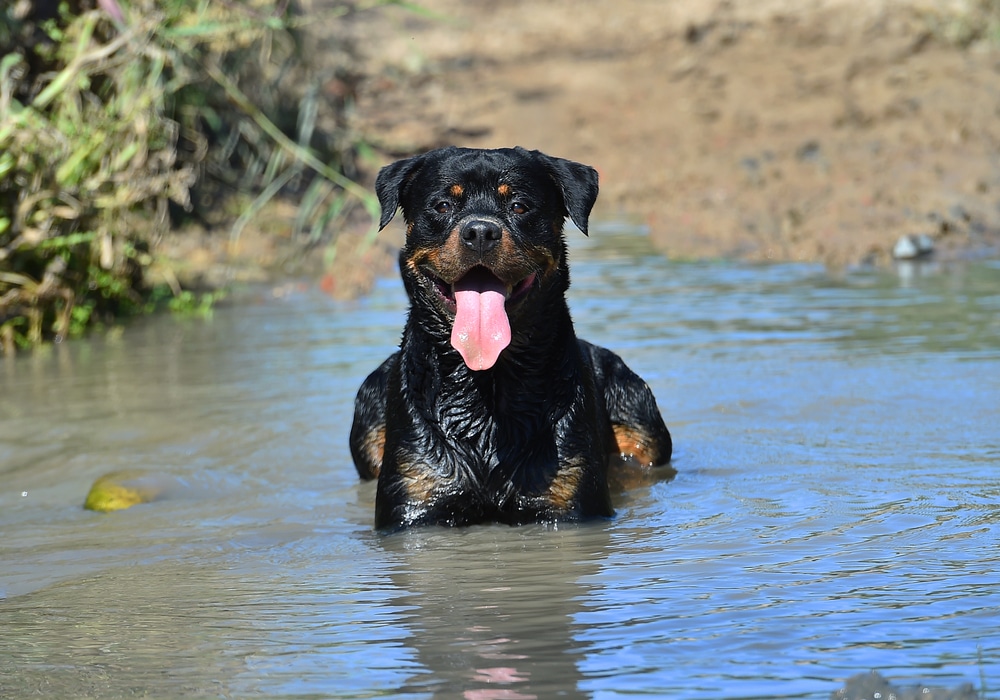
Can Rottweilers Handle the Heat?
Rotties are typically not good in extreme heat. They can suffer from heat exhaustion or even heatstroke if left out in the sun for too long.
“When temperatures hit 90°F or higher, it’s best to keep your pup inside to avoid any potential medical issues caused by excessive sun exposure.”
It’s also important to be aware of the things around them that could put them at risk in hot weather.
Hot surfaces can burn their paws, and being inside a car on a hot day is certainly not recommended.
Always take precautions on hot days, and remember that Rotties needs lots of cool water and shade to avoid getting dehydrated.
Cold Weather
Rotties are a robust breed and have thick coats to protect them from the cooler elements.
These dogs have been bred for centuries to guard and herd large animals in challenging climates, so they are well-equipped for wintery conditions.
However, care must still be taken when exposing your pup to cold temperatures.
If it has been a particularly harsh winter and you’re worried about your pet’s welfare, there are a few precautions you can take to ensure their comfort.
Providing shelter from strong winds and keeping up with regular grooming will help keep their fur healthy and insulate them from the chill of the outdoors.
Investing in appropriate clothing such as jackets or sweaters is also an option if your furry friend needs extra warmth on those chilly days.
How Long Can a Rottweiler Stay in the Snow?
As a general rule of thumb, Rotties can tolerate temperatures down to 20 degrees Fahrenheit (-6 Degrees Celsius).
“Their thick double coat will help them during these cold temperatures, but you shouldn’t keep them outside for too long.”
You should also provide them with proper shelter and warm clothing, helping them stay outside for extended periods of time without suffering from hypothermia or frostbite.
It’s also important to make sure your pup has plenty of food and water on hand.
This will ensure their body can produce enough heat to keep them warm.
Check out the video below, where these 2 Rottweilers have a fun day out in the snow!
Is the Rottweiler a Good Inside Dog?
Rotties have a reputation for being strong, loyal, and formidable guard dogs. But are they good inside dogs too?
While some people consider Rotties to be not suitable as house pets due to their size and strength, there is no denying that these powerful dogs have the potential to become great companions.
This breed can make the perfect indoor companion in the right home. They are highly intelligent animals with a desire to please their owners.
“Proper socialization and obedience training should start early in life so that they know how to behave around strangers and other animals.”
With the appropriate amount of exercise, attention, and love, a Rottweiler can fit comfortably into any household environment.
Rottweiler Lifespan
What is the average lifespan of a Rottweiler?
On average, the lifespan of a Rottweiler is between 8-10 years.
However, some may live longer or shorter depending on various factors such as diet, exercise, health care, and genetics.
A healthy lifestyle is key to prolonging the life of your Rottweiler.
Providing them with quality food and regular exercise is essential for their well-being and may even add extra years to their lives.
“Additionally, proper veterinary care can help identify any potential health issues that could shorten their lifespan if not addressed promptly.”
Genetics also play an important role in determining a Rottweiler’s longevity so it’s best to research the parents’ lineage before making a purchase from a breeder.
Rottweiler – Puppy Prices

What are the average prices of a Rottweiler?
When it comes to buying a Rottweiler, the average cost depends on several factors.
The breed’s origin, the breeder’s reputation, and the dog’s age all play a role in determining the price.
On average, you can expect to pay anywhere between $1200 and $2,500 for a healthy Rottweiler puppy from a reputable breeder.
The price range for adult dogs varies significantly depending on their pedigree; purebred adults can range from $1500 up to as much as $5,000 or more.
It is important to note that there are other costs associated with owning a Rottweiler that must be taken into consideration when budgeting for one.
Potential owners should plan on investing in obedience classes and regular vet visits as part of their canine companion’s upkeep.
Finding Your Rottweiler
Where to Buy a Rottweiler?
If you’re looking for a loyal, dependable, and protective companion, then a Rottweiler might be the perfect pet for you.
But with so many breeders available to choose from, it can be difficult to decide where to buy one. Here are some tips on finding a reliable and reputable breeder that will offer you the best possible Rottweiler puppy.
First off, research potential breeders in your area to ensure they have plenty of experience raising Rottweilers.
The American Kennel Club’s website is a great resource if your goal is to find an AKC-registered puppy; they provide information on approved breeders who follow their strict guidelines when breeding Rotties.
Additionally, there are several online forums dedicated solely to Rotties where people discuss different breeders and share advice based on personal experience with them.
Why are there so many Rottweilers Abandoned?
The abandonment of Rotties is a growing issue across the United States, with rescue organizations reporting a high number of abandoned animals each year.
But why are so many Rotties being left behind? Understanding the reasons for this can help us address and prevent this problem in the future.
Rotties have been popular for decades, due to their loyalty, intelligence, and strength. However, these same traits make them unsuitable as pets for people who are unprepared or unable to provide them with proper training.
Without socialization and guidance from an early age, Rotties may become aggressive and challenging to handle.
This leads many owners to abandon them, unfortunately, rather than face difficult behavior problems.
Why are there so many Rottweilers in Shelters?
Rotties are one of the most common breeds found in animal shelters throughout the US and beyond.
These loyal and intelligent dogs, once known as working dogs, are now unfortunately victims of over-breeding and neglect.
Due to their large size, high energy levels, and potential for aggression if not properly trained or socialized, many Rotties have ended up in animal shelters without homes. Shelters are seeing an influx of Rottweiler puppies due to breeders who keep producing more puppies than they can sell or care for.
This has caused a surplus of Rotties needing forever homes from shelters that may be overcrowded or underfunded.


